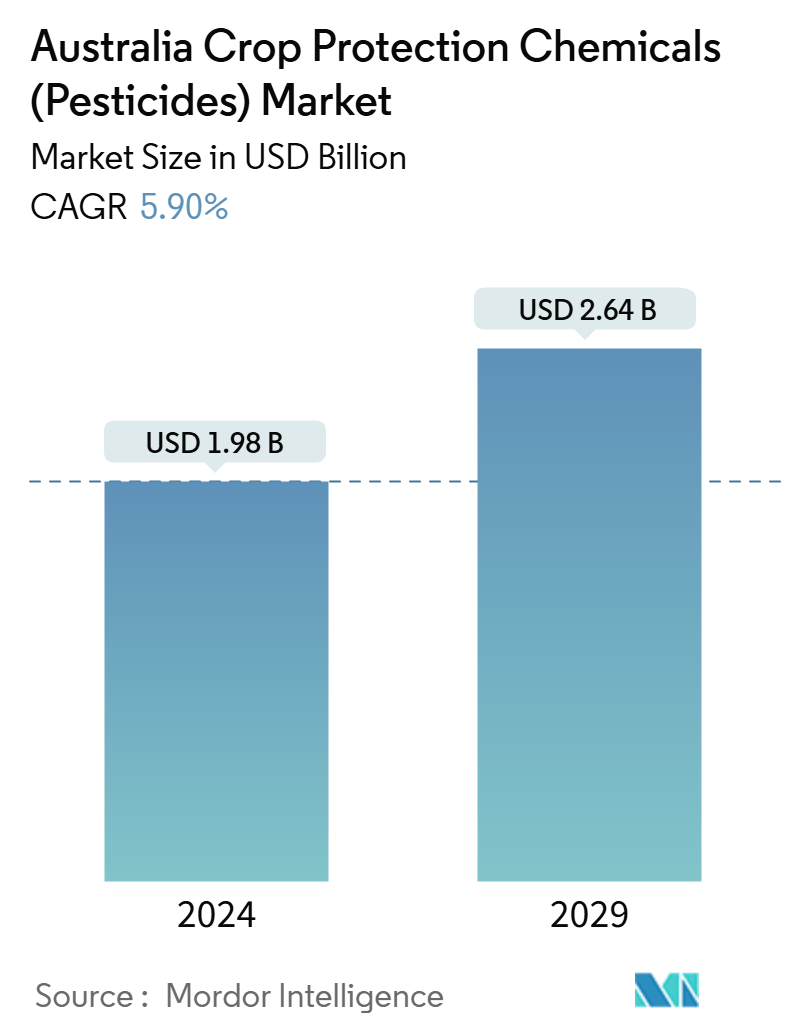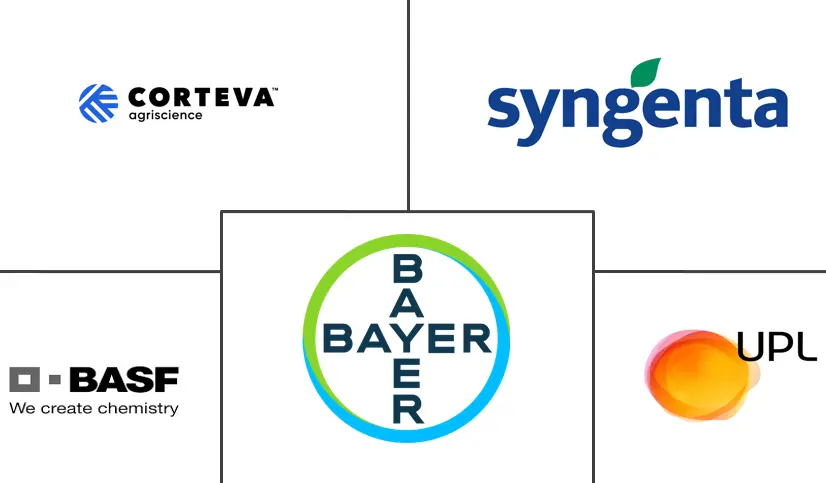Market Size of Australia Crop Protection Chemicals (Pesticides) Industry

| Study Period | 2019 - 2029 |
| Base Year For Estimation | 2023 |
| Market Size (2024) | USD 1.98 Billion |
| Market Size (2029) | USD 2.64 Billion |
| CAGR (2024 - 2029) | 5.90 % |
| Market Concentration | High |
Major Players
*Disclaimer: Major Players sorted in no particular order |
Australia Crop Protection Chemicals (Pesticides) Market Analysis
The Australia Crop Protection Chemicals Market size is estimated at USD 1.98 billion in 2024, and is expected to reach USD 2.64 billion by 2029, growing at a CAGR of 5.90% during the forecast period (2024-2029).
Australia has a thriving agricultural industry that plays a significant role in the country's economy. The vast land area, diverse climate, and advanced farming practices contribute to Australia's agricultural success.
- The Australian cultivation area witnessed a notable growth of 22.9%, from 22.2 million ha to 27.3 million ha in 2022. This increase in agricultural land can be attributed to the need to meet the rising demand for food. Therefore, there is a corresponding increase in the demand for efficient pest control methods, leading to the market's growth.
- The Australian Pesticides and Veterinary Medicines Authority (APVMA) regulates crop protection chemicals' use in Australia and is responsible for registering and approving pesticides and other agricultural chemicals. The APVMA ensures that these chemicals are safe for human health and the environment and effective in protecting crops.
- Increasing demand for food, pests and diseases, government support, technological advancements, increasing exports, and climate change rate drive the Australian crop protection chemicals market. Australia is a mature market for pesticides. Crops like wheat, barley, sugarcane, canola, cotton, vegetables, and fruits are largely grown in Australia and are major users of crop protection chemicals.
Australia Crop Protection Chemicals (Pesticides) Industry Segmentation
Pesticides are used to control a variety of agricultural pests that damage crops and reduce farm productivity.
The Australia Crop Protection Chemicals Market is segmented by Function (Fungicide, Herbicide, Insecticide, Molluscicide, Nematicide), by Application Mode (Chemigation, Foliar, Fumigation, Seed Treatment, Soil Treatment) and by Crop Type (Commercial Crops, Fruits & Vegetables, Grains & Cereals, Pulses & Oilseeds, Turf & Ornamental)
The report also offers the market sizing in terms of value (USD) and volume (metric ton).
| Function | |
| Herbicide | |
| Fungicide | |
| Insecticide | |
| Nematicide | |
| Molluscicide |
| Application Mode | |
| Chemigation | |
| Foliar | |
| Fumigation | |
| Seed Treatment | |
| Soil Treatment |
| Crop Type | |
| Commercial Crops | |
| Fruits and Vegetables | |
| Grains and Cereals | |
| Pulses and Oilseeds | |
| Turf and Ornamentals |
Australia Crop Protection Chemicals (Pesticides) Market Size Summary
The Australian crop protection chemicals market is experiencing steady growth, driven by the increasing demand for biopesticides and the adoption of herbicide-resistant crops. The market is regulated by the Australian Pesticides and Veterinary Medicines Authority (APVMA), which ensures the safety and efficacy of these chemicals. The demand for crop protection chemicals is fueled by factors such as the need to combat pests and diseases, government support, technological advancements, and the impact of climate change. Australia, being a mature market, sees significant pesticide use in the cultivation of crops like wheat, barley, sugarcane, canola, cotton, vegetables, and fruits. Biopesticides, derived from natural materials, are gaining traction due to their targeted and environmentally friendly approach, although they currently represent a smaller segment of the market.
The market is characterized by the presence of major players such as Syngenta International AG, Bayer CropScience AG, Corteva AgriScience, BASF SE, and UPL Limited, who collectively hold a significant share of the global market. These companies engage in strategies like new product launches, mergers, acquisitions, and partnerships to enhance their market presence. The demand for crop protection chemicals is particularly strong in the sugarcane industry, where pesticides are essential to mitigate losses from diseases. Despite the cessation of certain harmful chemicals, the use of specific insecticides and herbicides has increased in recent years. The market's growth is also supported by the rising area under organic cultivation, highlighting the increasing preference for bio-based solutions among Australian farmers.
Australia Crop Protection Chemicals (Pesticides) Market Size - Table of Contents
-
1. MARKET DYNAMICS
-
1.1 Market Overview
-
1.2 Market Drivers
-
1.3 Market Restraints
-
1.4 Porter's Five Forces Analysis
-
1.4.1 Bargaining Power of Suppliers
-
1.4.2 Bargaining Power of Buyers/Consumers
-
1.4.3 Threat of Substitute Products
-
1.4.4 Threat of New Entrants
-
1.4.5 Intensity of Competitive Rivalry
-
-
-
2. MARKET SEGMENTATION
-
2.1 Function
-
2.1.1 Herbicide
-
2.1.2 Fungicide
-
2.1.3 Insecticide
-
2.1.4 Nematicide
-
2.1.5 Molluscicide
-
-
2.2 Application Mode
-
2.2.1 Chemigation
-
2.2.2 Foliar
-
2.2.3 Fumigation
-
2.2.4 Seed Treatment
-
2.2.5 Soil Treatment
-
-
2.3 Crop Type
-
2.3.1 Commercial Crops
-
2.3.2 Fruits and Vegetables
-
2.3.3 Grains and Cereals
-
2.3.4 Pulses and Oilseeds
-
2.3.5 Turf and Ornamentals
-
-
Australia Crop Protection Chemicals (Pesticides) Market Size FAQs
How big is the Australia Crop Protection Chemicals Market?
The Australia Crop Protection Chemicals Market size is expected to reach USD 1.98 billion in 2024 and grow at a CAGR of 5.90% to reach USD 2.64 billion by 2029.
What is the current Australia Crop Protection Chemicals Market size?
In 2024, the Australia Crop Protection Chemicals Market size is expected to reach USD 1.98 billion.

